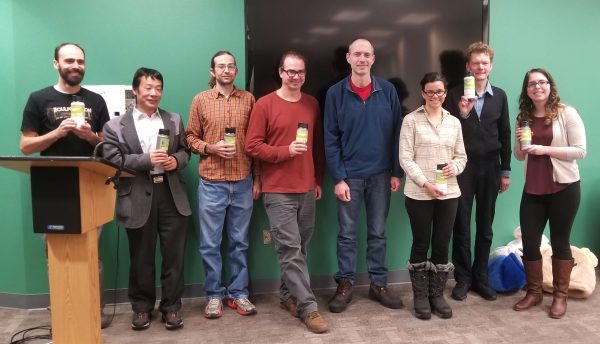Predictfest competition tackles real-world problems
December 13, 2017

How many more times will I have to plow my road this year?
Products developed by IARC researchers at this fall’s PredictFest can answer this question along with related questions of great significance.
Thirty IARC researchers recently gathered into three teams and spent two full days tackling a challenge, developing products, assembling business pitches, and even writing a song. This was PredictFest — a fast-paced, hackathon-style friendly competition. Each team was given the same temperature and precipitation data set and the simple game rules were set: quickly develop a product and business model, then be ready to pitch it in about 30 hours.
PredictFest was the idea of Erin Trochim, a postdoctoral student at the Alaska Climate Science Center and Lindsey Heaney, also with AK-CSC and Scenarios Network for Alaska and Arctic Planning. Hajo Eicken, director of IARC, was impressed with the deliberate and strategic efforts that went into planning PredictFest, and even more impressed with the outcomes.
“These research products and ideas, when you combine them, are a fully viable model to build on, and to see whether we can take this to commercialization," Eicken said.
The winner was the Winter Weather Outlook Services team, which created a snow-depth prediction app that can compare historical data with predictions for the coming winter. The tool would help public and private entities manage their business and personnel projections for the upcoming year. WWOS used strong data-processing capabilities, presented a solid company idea, and formulated a business plan including exercising due diligence in looking at possible competing business ideas.
Mentors were available to help teams develop their products.
One of the mentors, Ping Lan from the School of Management, was impressed by the products and the business models.
“These are first-class scientists, and they are capable of creating a first-class business," he said.
Eicken understands that researchers don’t always want to undertake product development and commercialization; researchers explore new approaches to doing these things where they can actually gain an edge. He looked toward students and postdocs at the university to take and run with the ideas, and the researchers would provide the support.
Collaboration and networking at the event was as important as the product design. In some cases members of the same research group were meeting for the first time and developing working relationships that would follow them back to their offices.
“This exercise is a great way to help build networks from inside the teams, and when a problem arises in a research group, a department or even at the university management level, this would be a good way to put resources toward that problem in a structured event that yields great results in a short amount of time," Eicken said.
Trochim says, “We all know how to do the research, but how do we translate that into a useful product?” Trochim, one of the organizers, asked rhetorically. She noted IARC researchers’ desire to collaborate more with other IARC research groups. The event also met some of the goals of IARC’s Experimental Arctic Prediction Initiative to promote professional development, produce innovative products and initiate coproduction.
Mark Billingsley, of the Office of Intellectual Property and Commercialization, and Gwen Holdmann, OIPC director and director of the Alaska Center for Energy and Power, along with OIPC ambassadors Rajive Ganguli and Peter Webley, helped mentor the teams on day one and then served as judges at the end of the day two.
How to commercialize basic research is highly relevant right now. Commercialization can generically refer to developing new products and repackaging data to target new research sponsors from government or industry. From that perspective, commercialization is a key to successfully diversifying research funding. More traditional commercialization — developing a product that can be licensed or sold — also represents great potential to support research funding as well as personally reward the inventor or author.
Next, organizers are looking at ways to expand the PredictFest model to a larger UAF community, and the winners are working more toward commercialization.
For more information, email uaf-oipc@alaska.edu.


